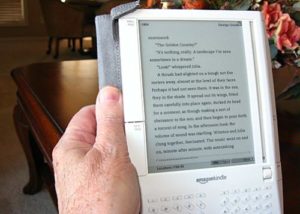
Princeton University has released findings from its semester-long pilot of Amazon.com’s Kindle DX electronic reader, and the results appear mixed: While students reduced the amount of paper they printed for their classes by nearly 50 percent, some students and professors said they felt restricted by the device.
“e-Readers must be significantly improved to have the same value in a teaching environment as traditional paper texts,” a university press release said.
Students and faculty who were surveyed after the pilot program ended said they appreciated the portability of the Kindle DX, and the fact that it greatly reduced the printing and photocopying they did for their courses. But they said they missed the ability to highlight text directly, take notes, and flip back and forth through pages of their textbook easily.
“With enhancements to their annotation capability, display of page numbers, and content organization, e-Readers and related technologies may help contain and ultimately reduce the amount of printing done by students at Princeton and elsewhere,” said Serge Goldstein, the university’s associate chief information officer and director of academic services. Goldstein also was one of the pilot project’s managers.
Princeton was one of a handful of universities that piloted the Kindle DX last fall, in part to help determine if e-Reader technology could reduce the use of paper without adversely affecting the classroom experience. Fifty students in three courses agreed to participate in the voluntary project at Princeton.
Graduate student Tabari Dossett, who received a Kindle DX after enrolling in the pilot course “U.S. Policy and Diplomacy in the Middle East,” said, “I only printed out two articles for this course all semester.”
He added: “Using the Kindle has made me a lot more conscious of my paper use. As a result of this experience, I have decided to not only keep my Kindle, but I have begun to use the Kindle for class readings for this semester. I have begun uploading readings from my computer onto the Kindle, which has also cut down on my printing hundreds of pages of readings so far this semester.”
Princeton students and faculty members who took part in the Kindle pilot received a free device that they could keep.
Sophomore Eddie Skolnick, who was enrolled in the undergraduate course “Civil Society and Public Policy,” said he had a less positive experience with the technology.
“I found the device limiting,” he said, adding: “But I can see how it can be used for pleasure reading.”
About 65 percent of the participants in the Princeton pilot said they would not buy another e-Reader now if theirs was broken. Almost all the participants said they were interested in following the technology to its next stages, however, because they think a device that works well in academia would be worth having.
The things students liked best about the Kindle DX included its battery life, the wireless connection, and the portability of the e-Reader device; the fact that all the course reading was on one device; the ability to search for content; and the readability of the screen, including the fact it could be read in full sunlight.
The top five suggestions that students had for improving the Kindle to make it more applicable for course work were (1) improving the ability to highlight and annotate PDF files; (2) improving the annotation tools; (3) providing a folder structure to keep similar readings together; (4) improving the highlighting function; and (5) improving the navigation within and between documents on the reader—including having more than one document open at the same time for purposes of comparison.
“The Kindle was not ideal for my class,” said Stanley Katz, director of Princeton’s Center for Arts and Cultural Policy Studies and professor in the Woodrow Wilson School of Public and International Affairs. He taught the civil society course and said the difficulty of the Kindle’s annotation feature and the lack of a highlighting capacity “were serious limitations.”
“We were also hampered by our inability to move from one place to another in the text during class discussion,” Katz said. “On the other hand, we were grateful to have all of the course readings available in a single, portable device, and the mid-course arrival of software that made it possible to read the course assignments on a PC was very welcome.”
Professor of Classics Harriet Flower, who taught the pilot course “Religion and Magic in Ancient Rome,” said it was almost always possible to teach in the same way using the Kindle as in any other seminar she has taught.
“The Kindle would be better for an academic setting if the PDF format worked more effectively,” she noted. “It is a great advantage always to have all the texts available without carrying too much around.”
Link:
Results of Princeton’s Kindle DX pilot
- Research: Social media has negative impact on academic performance - April 2, 2020
- Number 1: Social media has negative impact on academic performance - December 31, 2014
- 6 reasons campus networks must change - September 30, 2014
